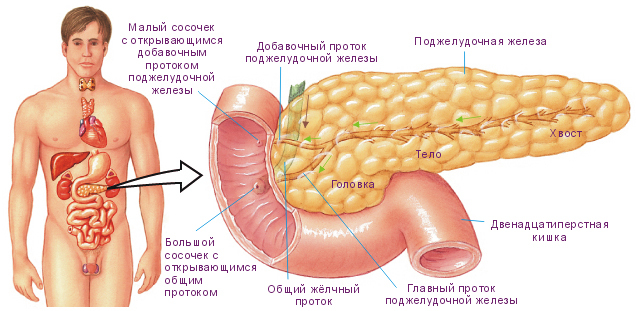Pancreatic obesity: fatty infiltration and degeneration
Pancreatic obesity develops against the background of such chronic organ pathologies as pancreatitis and diabetes mellitus.
This condition is really serious, and therefore needs not only timely determination, but also a well-chosen treatment course.

Content:
- 1 Some information about the organ
- 2 Features of the gland
- 3 Signs of pathology
- 4 Pancreatic obesity: stages of the pathological process
- 5 Causes of pathology
- 6 A course of treatment
- 7 Nuances in nutrition
- 8 Medication approach
- 9 And finally
- 10 Useful video
Some information about the organ
The pancreas should be understood as a small organ, the length of which is no more than 7 sentiments.
It is a glandular body. The pancreas is located in the deep parts of the abdominal part.
When food enters the human body, the gland takes over the function of producing special food enzymes.
They help to process food and break it down into micronutrients, better known as fats, proteins, and carbohydrates.
But that's not all. The functionality of the gland helps to produce a hormone such as insulin. It is known for its ability to utilize glucose in the human body.
Obesity of the pancreas, as a rule, does not manifest itself with vivid symptoms at the initial stages of the development of the disease.
For a long time, a person may not even suspect what is actually happening in his body.
Subsequently, fatty infiltration of the pancreas entails serious complications, and the process itself is irreversible.
Let's figure out what kind of danger this phenomenon carries in itself and how to accept a diagnosis for a patient.
Features of the gland
In fact, many people underestimate the pancreas. But this is one of the most important organs of the human system, ensuring normal life.
Of course, there are no useless systems in the body, Mother Nature has taken care of this. If a failure was detected, it is worth taking action immediately, because otherwise, serious problems cannot be avoided.
If the organ ceases to perform the functions that were mentioned a little above, fatty infiltration of the pancreas begins.
This process in the medical field is also called lipomatosis. It should be understood as the replacement of dead or damaged organ cells with adipose tissue.
Those areas that have been inflamed lose the ability to perform the duties assigned to them. They lose strength and subsequently die altogether. But the fat depot immediately comes to their place.
Outwardly, changes are not always noticeable, and they do not have vivid symptoms. This phenomenon is possible until fatty degeneration of the pancreas begins to squeeze the tissue.
It can also interfere with the functional work of the organs adjacent to the gland.
As a rule, this diagnosis can be established by doctors quite by accident, when the patient is sent for an ultrasound examination for a completely different reason.
The difficulties do not end there. The substitution process is not isolated. Other problems inevitably arise.
Often, the liver suffers, in which degeneration also begins. This phenomenon is called fatty hepatosis.
Signs of pathology
As noted above, as a rule, there are no clinical manifestations. Pathology can be detected during a regular check-up.
Symptoms become brighter when 1/3 of the gland tissue is covered with fat.
Signs will boil down to the fact that the person will face pain in the abdomen. It will be ubiquitous.
Attacks of nausea and vomiting may be present. Only after emptying the stomach will no relief be experienced.
Stool problems are possible. With diarrhea, there may be oily blotches in the stool. Also, patients complain of flatulence, heaviness in the epigastric region and left hypochondrium.
The characteristic symptomatology of fatty replacement of the gland can be attributed to a jump in blood glucose. This can be learned from the analysis of the patient's biomaterial.
If the cells of adipose tissue form groups, then the pathology can be complicated by a lipoma, which should be understood as a benign neoplasm.
It carries no potential danger. The point is that the tumor is not capable of rapidly progressing and being a source of metastases.
Pancreatic obesity: stages of the pathological process
Today, medical practitioners distinguish several stages of lipomatosis neglect.
They are determined on the basis of the ratio in percentage of the glandular and adipose tissue of the pancreas. Each of them can be found a little below:
- Stage 1. At the initial stage of pathology, adipose tissue can occupy no more than 30 percent of the organ.
- Stage 2. Pathology is gaining momentum. In such situations, substitution reaches 60 percent.
- Stage 3. Adipose tissue takes up 60 percent or more.
The doctor makes the final diagnosis based on the data obtained after the ultrasound examination of the patient.
The picture will show how the fat deposits are located and how profusely they crush the organ. Thanks to ultrasound, it is possible to determine lipomatosis with 100% accuracy.
You should trust your attending physician, who will develop a special therapy regimen that will help maintain the stable functioning of the organ for the patient to conduct normal life.
Causes of pathology
Of course, it will be important to note in this article the reasons entailing such a dangerous pathology.
The trouble comes due to the disturbed metabolism in the body. Lipomatosis should not be considered the cause of pathological changes.
The disease is a consequence of the fact that an acute or chronic form of inflammation of the pancreas or the replacement of liver cells with fat is observed in the body.
An important role in this will be played by the excessive consumption of alcoholic beverages by a person, the patient's obesity.
A significant contribution to the development of lipomatosis is made by a hereditary factor, as well as those situations when pancreatitis was treated with the wrong means of therapy, only aggravating the situation.
A course of treatment
Approaching the issue of treating lipomatosis, it is worth noting that in no case should you self-medicate for this pathology.
Having found a malfunction in the body, you need to immediately go to an appointment with a doctor. You can seek help from a therapist who will write an appointment for a narrow specialist.
In the section of therapeutic therapy, it is worth identifying general recommendations for eliminating fatty infiltration of the gland.
First of all, this is the transition to fractional meals. You need to adhere to the diet prescribed by your doctor, refuse to take alcoholic beverages. The doctor will prescribe the intake of insulin and enzymes.
It is possible that in advanced cases, an operation will be performed. As a rule, this applies to the 3rd degree of pathology.
The doctor will conduct a complete examination of the patient's body and issue a verdict. The doctor needs to be trusted and rely on his qualified opinion.
It should also be noted that pancreatic obesity is not recorded in all those who suffer from pancreatitis.
Often, those people who are overweight are at risk.
If a person has been diagnosed with alimentary obesity, it is recommended to undergo an examination in order to know for sure that the gland does not suffer from fatty deposits.
Since the pancreas is one of the main organs of the digestive system, it will not be possible to restore the work of the gland without debugging the nutrition.
It is recommended to personally find out what are the nutritional characteristics of lipomatosis.
Nuances in nutrition
If you are diagnosed with pancreatic obesity, you should definitely follow all the doctor's prescriptions and adhere to nutritional characteristics. All this will eliminate the negative effect on the gland.
A therapeutic diet can also be used as a preventative measure. It involves the consumption of unsaturated fatty acids.
You can get them in vegetable oil. It is worth removing from the diet those foods that are poorly absorbed, respectively, do not allow the digestive act to pass normally.
They are also able to increase the intensity of inflammation in the pancreatic parenchyma. These are fatty and fried foods, alcoholic, spicy, spices and seasonings.
The list of forbidden treats should include fresh baked goods, confectionery products, salty and a variety of sauces.
If lipomatosis is associated with a diagnosis of diabetes mellitus, then the diet should not contain a lot of carbohydrates.
A fractional diet for obesity in the pancreas is optimal. He provides for the use of food 5-6 times a day, while portions should not be more than 250-300 grams.
It is not recommended to eat 2 hours before bedtime. This technique avoids stress on the pancreas.
It is recommended to completely give up the habit of lying down after a hearty meal. This negatively affects the state of the most important organs of the gastrointestinal tract.
An obligatory measure is the debugging of the drinking regime. A patient with lipomatosis should drink 2.5 liters of water per day.
This does not include infusions, teas, fruit drinks or compotes. It should be pure plain water. You can also drink mineral sulphate-magnesium water.
Herbal decoctions are considered effective in the fight against lipomatosis. It is recommended to make them on the basis of immortelle, rose hips, wormwood or calendula flowering.
But know that without consulting your doctor, you should not use them in practice.
The thing is that each case is individual, and therefore it is possible that even a natural product can harm a patient with an obese gland.
The use of low-fat fermented milk products will also help relieve the load on the body. Choose products from 0 to 5 percent fat.
It is better if this is a home cooking option, since the exact composition is not always indicated on store products.
Cheeses, especially hard varieties, will be useful. You need to eat cereals that are filled with useful trace elements.
You can include fish in the diet, but only boiled or steamed.
Medication approach
Exclusively the doctor is able to choose the right medication for pancreatic obesity.
As a rule, the emphasis in treatment is on the reception of funds that help to establish the work of the digestive tract.
On the basis of food enzymes, drugs such as Festal, Mezim or Pancreatin have been created. They can be prescribed by a gastroenterologist.
It is also possible to take antispasmodics - No-shpa, Platyphyllin, etc. Medications that can normalize hormonal levels may be required. You need to take them carefully, without violating the course and dosage.
In situations with an advanced stage of gland obesity, surgical intervention is prescribed.
Surgical methods are aimed at removing fat cells in the organ. It is worth noting here that adipose tissue can subsequently be replaced by scar tissue, and therefore it is impossible to talk about a long-term result of operations on the gland.
And finally
As practice shows, in the treatment of problems with the pancreas, an integrated approach of all the above methods is important.
The patient is required to be attentive to his body, fulfill all the doctor's prescriptions and adhere to a sparing diet.


